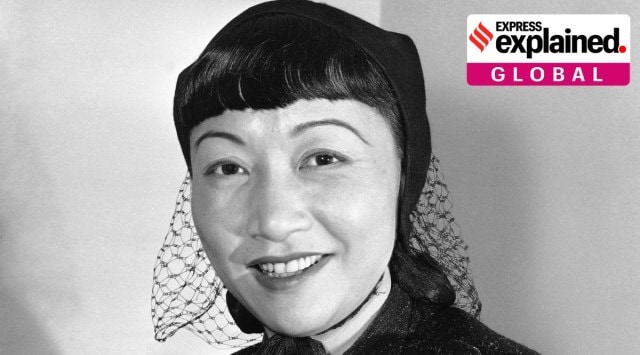Latest Comment
Post Comment
Read Comments
 Chinese-American actress Anna May Wong. More than 60 years after her death, Wong will be the first Asian American to grace U.S. currency. The U.S. Mint announced it will begin shipping quarters with her likeness later this month. (AP Photo/Carl Nesensohn, File)
Chinese-American actress Anna May Wong. More than 60 years after her death, Wong will be the first Asian American to grace U.S. currency. The U.S. Mint announced it will begin shipping quarters with her likeness later this month. (AP Photo/Carl Nesensohn, File)Late Hollywood actress and fashion icon Anna May Wong (1905-1961) is set to become the first Asian American to feature on US currency. A quarter-dollar coin featuring a close-up image of Wong’s face chin resting on her hand will begin circulating from Monday (October 24), the US Mint said, as the fifth coin in the American Women Quarters (AWQ) Program.
📷 On October 24, the @usmint will begin shipping quarters honoring Anna May Wong, a trailblazing Chinese American actress who left a lasting legacy for Asian American women with an accomplished career in motion pictures, television, and theatre. pic.twitter.com/HxltR0rH3J
— White House Initiative on AA and NHPIs (@WHIAANHPI) October 19, 2022
Regarded as the film industry’s first Chinese-American star, Wong’s decades-long career in motion pictures, television and theatre came at a time of widespread racism. “Along with the hard work, determination, and skill Anna May Wong brought to the profession of acting, I think it was her face and expressive gestures that really captivated movie audiences, so I included these elements next to her name,” said US mint designer Emily Damstra.
Born with the birth name Wong Liu-Tsong to second-generation Chinese immigrants in Los Angeles, Wong started her film career at the age of 14 as an extra in The Red Lantern (1919). She gained critical acclaim only three years later when she played the leading role in The Toll of the Sea (1922), one of the first Technicolour films.
Wong would go on to appear in more than 60 movies, including the box-office hit Shanghai Express (1932), and acted alongside stars such as Marlene Dietrich, Laurence Olivier and Joan Crawford, CNN reported. She was also the first Asian American leading actor in a television show, The Gallery of Madame Liu-Tsong (1951).
Despite her successes, due to the prevailing racism at the time, Wong struggled to find appropriate roles to play in Hollywood. She went to Europe where she found better opportunities to work in German, British and French cinema, but returned to the US in the 1930s.
Wong’s career was at a time of widespread anti-Asian sentiment in the country, along with domination of stereotypical representations in Hollywood, with white actors playing East Asian characters as part of a practice that is now seen as discriminatory and stereotypical, and termed “yellowface.”
Wong was often typecast in roles, forced to portray exoticised stereotypes of the East Asian “Dragon Lady” — domineering, but sexually promiscuous women in films like The Thief of Bagdad (1924) or Daughter of the Dragon (1931). Despite being acclaimed as one of the most beautiful women in Hollywood, she was nonetheless unable to play romantic leads because of laws restricting actors of different races from kissing on screen, The New York Times reported.
Well aware of the pervasive discrimination, Wong said in a 1933 interview with The Los Angeles Times, “I was so tired of the parts I had to play. Why is it that the screen Chinese is nearly always the villain of the piece, and so cruel a villain — murderous, treacherous, a snake in the grass? We are not like that.”
When cast for the film, The Good Earth (1937), Wong was widely considered to play the leading role of O-Lan. She was instead offered the role of a sex worker who becomes the concubine of O-Lan’s husband, but refused to play the sole Asian cast member, The Washington Post reported. The leading roles were given to white actors, and Luise Rainer, who was cast as O-Lan, won the Oscar for Best Actress for her performance.
Wong has previously been recognised for her impact on the film industry. In 1960, she was the first Asian American actress to receive a star on the Hollywood Walk of Fame. When Lucy Liu became the second Asian American woman to do so in 2019, she eulogised Wong for being “a pioneer while enduring racism, marginalisation, and exclusion,” The Guardian reported.
A biopic of life is also currently being produced, with English actress Gemma Chan from the film Crazy Rich Asians (2018) starring as Wong. The quarter-dollar coin, which features Anna May Wong, also includes the Latin phrase “E PLURIBUS UNUM” (out of many, one).
US Mint Director Ventris C. Gibson called Wong “a courageous advocate who championed for increased representation and more multi-dimensional roles for Asian American actors.” She added, “This quarter is designed to reflect the breadth and depth of accomplishments by Anna May Wong, who overcame challenges and obstacles she faced during her lifetime.”




